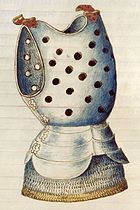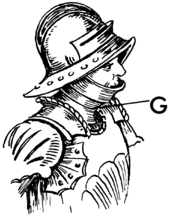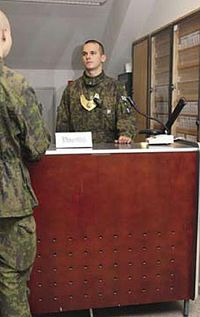- Gorget
-
For the feathers, see gorget (bird).
 The gorget shown in this 1772 portrait of Colonel George Washington by Charles Willson Peale, worn as part of Washington's uniform in the French and Indian War to symbolize his commission as an officer in the Virginia Regiment, was given to Josiah Quincy III in March 1813 by the granddaughter of Washington at Tudor Place.[1] Josiah Quincy III subsequently gave the gorget to the Washington Benevolent Society of Boston.[1]
The gorget shown in this 1772 portrait of Colonel George Washington by Charles Willson Peale, worn as part of Washington's uniform in the French and Indian War to symbolize his commission as an officer in the Virginia Regiment, was given to Josiah Quincy III in March 1813 by the granddaughter of Washington at Tudor Place.[1] Josiah Quincy III subsequently gave the gorget to the Washington Benevolent Society of Boston.[1]
A gorget (
 /ˈɡɔrdʒɨt/) originally was a steel or leather collar designed to protect the throat. It was a feature of older types of armour and intended to protect against swords and other non-projectile weapons. Later, particularly from the 18th century onwards, the gorget became primarily ornamental, serving only as a symbolic accessory on military uniforms.
/ˈɡɔrdʒɨt/) originally was a steel or leather collar designed to protect the throat. It was a feature of older types of armour and intended to protect against swords and other non-projectile weapons. Later, particularly from the 18th century onwards, the gorget became primarily ornamental, serving only as a symbolic accessory on military uniforms.Contents
As part of armour
Most Medieval versions of gorgets were simple neck protectors that were worn under the breastplate and backplate set. These neck plates supported the weight of the armour worn over it, and many were equipped with straps for attaching the heavier armour plates.
Later, Renaissance gorgets were not worn with a breastplate but instead were worn over the clothing. Most gorgets of this period were beautifully etched, gilt, engraved, chased, embossed, or enamelled and probably very expensive.
The Japanese (samurai) form of the gorget is known as a nodowa.
As part of military uniforms
As early as 1688, regulations provided for the wearing of gorgets by Swedish army officers. For those of captain's rank the gorget was gilt with the king's monogram under a crown in blue enamel, while more junior officers wore silver-plated gorgets with the initials in gold.[2]
During the 18th and early 19th centuries, crescent-shaped gorgets of silver or silver gilt were worn by officers in most European armies, both as a badge of rank and an indication that they were on duty. These last survivals of armour were much smaller (usually about three to four inches in width) than their Medieval predecessors and were suspended by chains or ribbons. In the British service they carried the Royal coat of arms until 1796 and thereafter the Royal cypher.
Gorgets ceased to be worn by British army officers in 1830, and by their French counterparts 20 years later. They were still worn to a limited extent in the Imperial German Army until 1914, as a special distinction by officers of the Prussian Gardes du Corps and the 2nd Cuirassiers "Queen". Officers of the Spanish infantry continued to wear gorgets with the cypher of King Alfonso XIII in full dress until the overthrow of the Monarchy in 1931. Mexican Federal army officers also wore the gorget with the badge of their branch as part of their uniform until 1947. This practice ended in 1947 but the gorgets are still used by all units when on guard duty. Recently the Mexican army's new 2010 model dress uniforms have re-incorporated the gorgets.
The gorget was revived as a uniform accessory during Germany's Third Reich, seeing widespread use within the German military and Nazi party organizations. During World War II, it continued to be used by German military field police, which wore metal gorgets as emblems of authority. German police gorgets of this period typically were flat metal crescents with ornamental designs that were suspended by a chain worn around the neck. Following the German example, the Finnish Defence Forces still use a metal gorget as a distinguishing mark of the duty conscript of a company, and the highly prussianised Chilean army still use the German style metal gorget in parades and in the uniform of their own Military Police.
Gorgets in Sweden
The gorget was discontinued as a rank insignia for Swedish officers in the Swedish Armed Forces as of the year 1792, when epaulettes where introduced. However, use of the gorget was revived in 1799, when the Officer of the day was given the privilege of wearing a gorget which featured the Swedish lesser coat of arms. It has since been a part of the officers uniform (when he or she functions as "Officer of the day"), a custom which continues to this day. The same use of the gorget also continues in Norway, worn by officers / corporals responsible for guard changes, and "Inspecting Officers" (officer of the day).
Gorget patches
Main article: Gorget patchesThe scarlet patches still worn on each side of the collar of the tunics of British Army general officers, and senior officers (in red, blue, crimson, yellow, or green according to branch) are called "gorget patches" in reference to this article of armour. Air officers in the Indian and Sri Lankan air forces also wear gorget patches with one to five stars depending on their seniority.[3]
RAF officer cadets wear white gorget patches on their service dress and mess-dress uniforms. Very similar collar patches are worn by British army officer cadets at Sandhurst on the standup collars of their dark-blue "Number One" dress uniforms. These features of modern uniforms are a residual survival from the earlier practice of suspending the actual gorgets from ribbons attached to buttons on both collars of the uniform. Such buttons were often mounted on a patch of coloured cloth or gold embroidery.
The functional gorget today
Recent advances in protective armour have led to the gorget being reintroduced into the US Army and Marine Improved Outer Tactical Vest and Modular Tactical Vest systems respectively.
Other uses
The state flag of South Carolina may feature a stylized gorget in its upper-left quadrant, although this is a matter of controversy.[4]
The term also refers to a broad patch of metallic-looking iridescent feathers on the throats of many male hummingbirds.
In colonial Australia gorgets were given to Aboriginal men by government officials and pastoralists as insignia of high rank or reward for services to the settler community. Frequently inscribed with the word "King" along with the name of the tribal group to which the recipient belonged (despite the absence of this kind of rank among indigenous Australians), the "breastplates", as they came to be known, were highly regarded by those Aboriginal men who received one.[5] A number of these breastplates are included in the collection of the National Museum of Australia.
See also
References
- ^ a b Lossing, Benson John (1859). Mount Vernon and its associations: historical, biographical, and pictorial. W.A. Townsend and Company. p. 345.
- ^ Preben Kannik, Alverdens Uniformer I Farver", p.151
- ^ http://www.bharat-rakshak.com/IAF/Heraldry/Uniform/380-Collar-Tabs.html
- ^ Hicks, Brian (July 11, 2007). "What the heck is that doodad on our state flag?". The Post and Courier (Charleston, South Carolina). http://www.postandcourier.com/news/2007/jul/11/what_heck_doodad_our_state_flag/.
- ^ http://www.nma.gov.au/exhibitions/aboriginal_breastplates
Head Armet · Barbute · Bascinet · Burgonet · Cervelliere · Close helm · Close helmet · Great helm · Frog mouth(helm) · Hounskull · Lobster tail pot · Mail coif · Morion · Nasal helmet · Sallet · Spangenhelm · Kettle hat
Visor · Falling buffe · Nossel
Neck Torso Brigandine · Cuirass · Culet · Plackart · Fauld · Hauberk · Codpiece · Lance rest · Loin-guard · Jack of plateArms Legs Component pieces Categories:- Medieval armour
- Personal armour
- Military uniforms
- Neckwear
Wikimedia Foundation. 2010.




